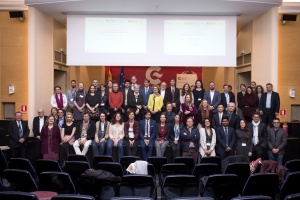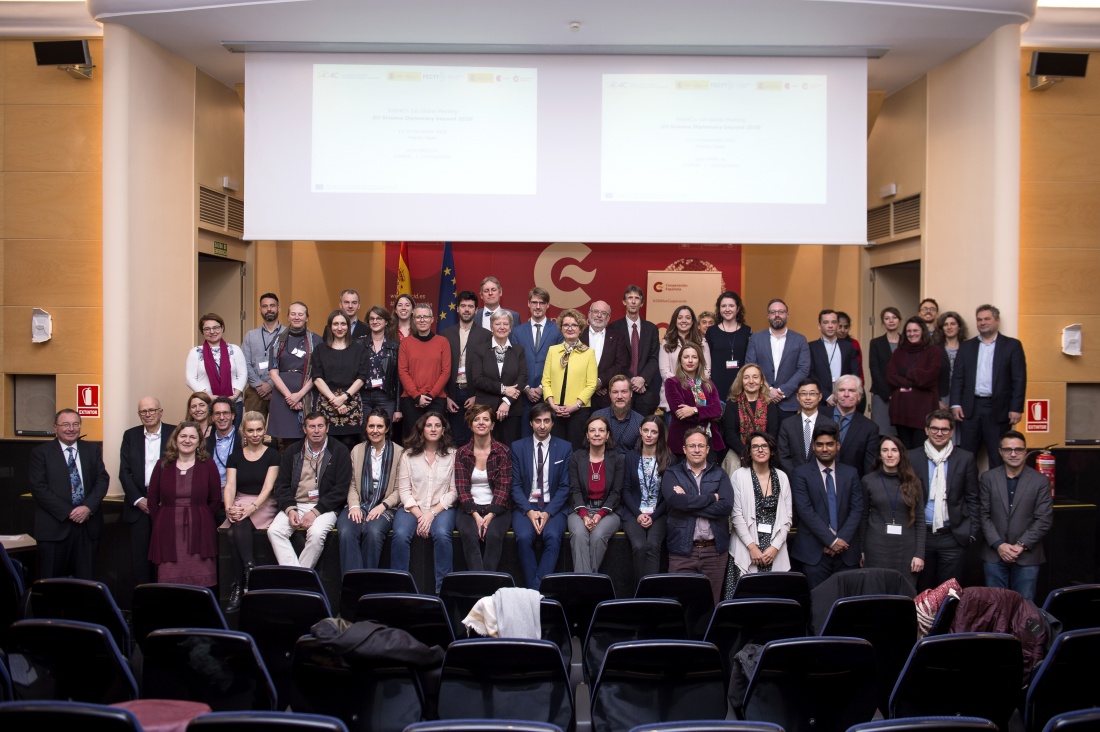A truly global community of science diplomacy scholars and practitioners met on the occasion of S4D4C’s 1st Global Meeting, which took place 12-14 December at the headquarters of the Spanish Agency for International Development Cooperation (AECID) in Madrid. Speakers and attendants of the conference came not only from Europe, but also from Canada, China, India, Korea, México, Panama and the U.S. The group gathered to explore the state-of-play in global science diplomacy in view of the potential for EU science diplomacy beyond 2020.
In his opening address, the Spanish Minister of Science, Innovation and Universities, Pedro Duque, illustrated the Spanish commitment to science diplomacy referring to the work of the Ministry and affiliated agencies like S4D4C’s partner institution and event host FECYT, the Foundation for Science and Technology. AECID Director Aina Calvo pointed to the relevance of science diplomacy from a development cooperation and foreign policy perspective.
After the official opening ceremony, Peter Gluckman, Chair of the International Network on Government Science Advice and President-elect of the International Science Council, was the first speaker to address the audience from a content perspective. In his keynote address, he recurred to the example of New Zealand to show how science diplomacy in the interest of individual nation-states can lead to the recognition and realisation of opportunities in global science diplomacy.
His intervention was followed by a keynote conversation between Cristina Fraile and Robin Grimes that provided a window onto the everyday lifeworlds of diplomats and science advisors.
Day 2 – Science diplomacy is here to stay
The second day of the conference started with a keynote by Nicole Grobert on science advice at the European Union level and her personal journey from research and the Young Academy of Europe to a major science advice position. Three sessions then focused on science diplomacy as key to advance a country’s national needs, cross-border interests and global needs, respectively. These sessions provided a snapshot of current discussions on science diplomacy and discussed some particularly visible examples.
Robin Grimes‘ keynote drew from his rich experience in various government science advice positions as well as in the Royal Society. Among other things, he referred to one key advantage of formalised science advice positions: they allow various government stakeholders to have one interlocutor to turn to.
The following panel explicitly asked the question of the present and future of EU science diplomacy. Among the most important issues raised were the vertical (regions, Member States, EU level) and horizontal (various EU institutions) coordination of science diplomacy, the question of labelling science diplomacy, its integration into the EU’s foreign policy agenda, as well as the relations between science diplomacy and scientific communities within and beyond Europe.
The second day was completed by a keynote of Mona Nemer on Canada’s approach to science advice and science diplomacy. She shared an interesting observation from the beginning of her mandate: there seemed to be too much advice, not too little. One of her main tasks were coordination and consolidation of the various stakeholders in governmental science advice.
Our S4D4C colleague and work package leader Mitchell Young was tasked to wrap up the first day’s discussions and did so pointing to the need for science diplomacy to conceptualise not only practices and interests, but also challenges.
Day 3 – The past is not the prologue
Former AAAS Chief International Officer Tom Wang started the third day with a thought provoking keynote on how to advance science diplomacy beyond its past. He pointed out that crossing boundaries between science and diplomacy is not equal to integrating both areas. He furthermore argued for rethinking the science diplomacy field by looking at non-traditional stakeholders and new forms of institutionalisation.
Tom’s intervention was followed by two panel discussions. The panel ‘Does one size fit all?’ looked at various national models of implementing science diplomacy. The following panel asked the question of the training in science diplomacy. Some panelists spoke of lateral moves in their own careers, versatility, and ‘life-changing events’ that brought them to SD. In terms of training experiences and recommendations, there was consensus that interactive and practice-oriented training modes are required that allow practitioners to take practical lessons back to their everyday jobs. The panelists also discussed the variety of career paths into science diplomacy.
The final highlight of the conference was the keynote of HE Ambassador Marie-Anne Coninsx, EU Ambassador for the Arctic. Ms Coninsx referred to the example of the governance of the Arctic to illustrate how science and diplomacy need each other. Diplomats working on areas like climate change need science and are used to recur to science advice. At the European External Action Service, the absence of a formalised EU science diplomacy strategy does not impede the practice of science diplomacy. Science diplomacy is going on e.g. with regard to the Arctic where science advice led to better policies as well as to supranational agreements that strengthened international ties.
Summing up
S4D4C’s Alexander Degelsegger-Márquez wrapped up the conference by recapping some of the major outcomes of the three days’ discussions: Science diplomacy as a practice is here to stay. However, it is important to distinguish explicit and implicit forms of science diplomacy, being aware of the effects of labelling. The appropriate form of institutionalising science diplomacy is an open point of discussion. In this regard, it is important to remember that not all countries will be able to use all forms of science diplomacy. The role of non-governmental players is likely to increase further. Complexity is also added by the fact that science is more tied to economic impact rationales. Science diplomacy interventions occur when a diffuse set of needs and interests at different levels (national, global, etc.) converges. It is useful to think about challenges as the point of ‘crystallisation’ around which needs and interests cluster and where they can be addressed in coordinated fashion.
Check back later for a more detailed documentation of the conference!


